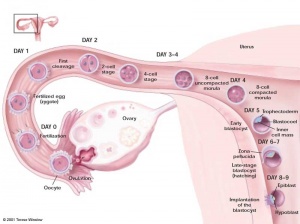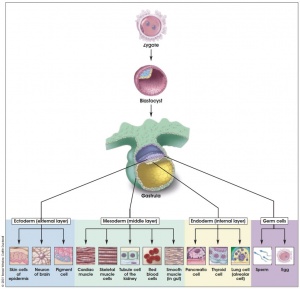Lecture - Stem Cells: Difference between revisions
No edit summary |
|||
| (65 intermediate revisions by 3 users not shown) | |||
| Line 1: | Line 1: | ||
==Introduction== | ==Introduction== | ||
[[File:Week 1_cartoon.jpg|thumb| Week 1 human development]] | [[File:Week 1_cartoon.jpg|thumb|300px| Week 1 human development]] | ||
[[File:Inner_cell_mass_cartoon.jpg|thumb|Blastocyst development]] | [[File:Inner_cell_mass_cartoon.jpg|thumb|300px|Blastocyst development]] | ||
Embryology is all about stem cells, a single cell (zygote) divides and differentiates to form all the tissues throughout the body. Furthermore within some tissues, stem cells remain to continuously replace cells that are lost through the life of that tissue. In recent years | Embryology is all about stem cells, a single cell (zygote) divides and differentiates to form all the tissues throughout the body. Furthermore within some tissues, stem cells remain to continuously replace cells that are lost through the life of that tissue. In recent years scientific and general interest in this topic has increased due to the many issues that surround this specialised cell type. This lecture will introduce the various types/sources of stem cells as well as their practical and therapeutic potentials. A brief discussion of the pros and cons of different types of stem cells currently investigated in the field of medical research will be discussed. | ||
Here are the slides for today's lecture [[Media:ANAT2341-2018-_Stem_cell_biology_and_technology.pdf|2018 - Stem cell biology and technology]]. | |||
== | ==Objectives== | ||
* | * Tissue development and regeneration Stem cell biology | ||
* | * Stem cell niches | ||
* | * Stem cell regulation | ||
* | * Stem cells and cancer Regenerative medicine | ||
* | * Stem cell sources | ||
* | * Future of regenerative medicine | ||
==Additional Lecture Resources== | |||
{| class="wikitable mw-collapsible mw-collapsed" | |||
! colspan=2|References | |||
|- | |||
| {{Embryo logocitation}} | |||
| | |||
{{Stem Cell Links}} | |||
Archive: [[Media:ANAT2341 - Stem cell biology and technology - 2016.pdf|2016 PDF]] | [[Media:ANAT2341Beverdam2015 - Stem cell biology and technology.pdf|2015 PDF]] | [[Media:ANAT2341Beverdam2014 - Stem cell biology and technology.pdf|2014 PDF]] | |||
[[ | |- | ||
= | | valign=top|The Nobel Prize in Physiology or Medicine 2012 | ||
| Awarded jointly to Sir John B. Gurdon and Shinya Yamanaka "''for the discovery that mature cells can be reprogrammed to become pluripotent''" | |||
* '''Yamanaka Factors''' Are a set of 4 transcription factors when introduced into cells induces stem cell formation. PMID 16904174 | PMID 18035408 | PMID 20535199 | |||
* | * '''John Gurdon''' used nuclear transplantation and cloning to show that the nucleus of a differentiated somatic cell retains the totipotency necessary to form a whole organism. | ||
* | **[http://www.sciencedirect.com/science/article/pii/S0960982203006845 2003 Current Biology Interview] PMID 14521852 2009 Interview - [http://www.ncbi.nlm.nih.gov/pmc/articles/PMC2615171 "The birth of cloning"] PMID 19132124 | ||
* | |||
[[Stem Cells - Induced]] | |||
|- | |||
| valign=top|Stem Cell Therapies | |||
| Opportunities for Ensuring the Quality and Safety of Clinical Offerings: Summary of a Joint Workshop. | |||
Board on Health Sciences Policy; Board on Life Sciences; Division on Earth and Life Studies; Institute of Medicine; National Academy of Sciences. | |||
Washington (DC): National Academies Press (US); 2014 Jun 18. http://www.ncbi.nlm.nih.gov/books/NBK223197 | |||
|- | |||
| NIH Report | |||
| [http://stemcells.nih.gov/info/2006report/ NIH - Regenerative Medicine 2006] | |||
|} | |||
{{ | {{2017ANAT2341 footer}} | ||
Latest revision as of 09:58, 15 October 2018
Introduction
Embryology is all about stem cells, a single cell (zygote) divides and differentiates to form all the tissues throughout the body. Furthermore within some tissues, stem cells remain to continuously replace cells that are lost through the life of that tissue. In recent years scientific and general interest in this topic has increased due to the many issues that surround this specialised cell type. This lecture will introduce the various types/sources of stem cells as well as their practical and therapeutic potentials. A brief discussion of the pros and cons of different types of stem cells currently investigated in the field of medical research will be discussed.
Here are the slides for today's lecture 2018 - Stem cell biology and technology.
Objectives
- Tissue development and regeneration Stem cell biology
- Stem cell niches
- Stem cell regulation
- Stem cells and cancer Regenerative medicine
- Stem cell sources
- Future of regenerative medicine
Additional Lecture Resources
| References | |
|---|---|
| Hill, M.A. (2020). UNSW Embryology (20th ed.) Retrieved May 4, 2024, from https://embryology.med.unsw.edu.au | |
| The Nobel Prize in Physiology or Medicine 2012 | Awarded jointly to Sir John B. Gurdon and Shinya Yamanaka "for the discovery that mature cells can be reprogrammed to become pluripotent"
|
| Stem Cell Therapies | Opportunities for Ensuring the Quality and Safety of Clinical Offerings: Summary of a Joint Workshop.
Board on Health Sciences Policy; Board on Life Sciences; Division on Earth and Life Studies; Institute of Medicine; National Academy of Sciences. Washington (DC): National Academies Press (US); 2014 Jun 18. http://www.ncbi.nlm.nih.gov/books/NBK223197 |
| NIH Report | NIH - Regenerative Medicine 2006 |


